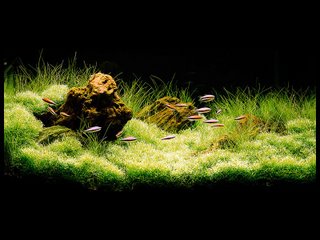 I've just stumbled upon this very interesting article on what the ideal level of light for an aquarium is according to the aquascapes of Takashi Amano. World-renowned aquascaper and founder of the Aqua Design Amano (ADA) contest and sponsoring company, Amano has published several books of his aquascapes and given light levels along with almost every aquascape. Using this information, John Fitch has not only discovered that Amano uses more light per gallon on smaller tanks, but has also developed a calculator to determine, using the data from Amano's tanks, roughly what light level Amano would be likely use on your aquarium. The calculator can be found in the article, which is called "Lighting as a Function of Tank Size in the Aquaria of Takashi Amano."
I've just stumbled upon this very interesting article on what the ideal level of light for an aquarium is according to the aquascapes of Takashi Amano. World-renowned aquascaper and founder of the Aqua Design Amano (ADA) contest and sponsoring company, Amano has published several books of his aquascapes and given light levels along with almost every aquascape. Using this information, John Fitch has not only discovered that Amano uses more light per gallon on smaller tanks, but has also developed a calculator to determine, using the data from Amano's tanks, roughly what light level Amano would be likely use on your aquarium. The calculator can be found in the article, which is called "Lighting as a Function of Tank Size in the Aquaria of Takashi Amano."This is further evidence against the Watts per Gallon rule, which was always just a rough guide. In other words, 40 watts over a 10 gallon tank may seem like a lot of light (4WPG), but in fact, it should have closer to 65 watts. The reason for this is due to surface area, but exactly why I haven't quite gotten a handle on yet, so I'll do more research and report back when I have a better idea. All I know is that smaller tanks demand more light per volume and larger tanks demand less. The WPG rule holds for the most part in medium sized tanks (about 29 gallons to 55 gallons), but below and above that, it's better to go by something like this tool, or do your own calculations using surface area (-gulp-). Personally, I like the tool...
















